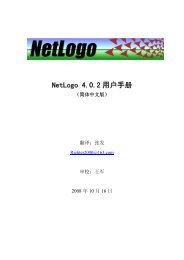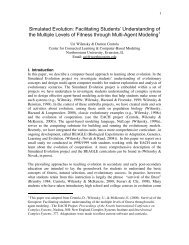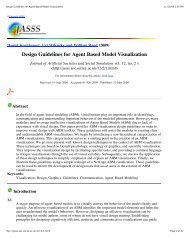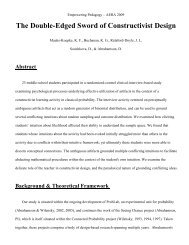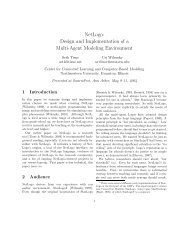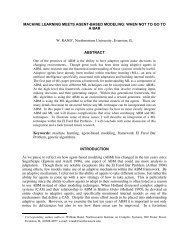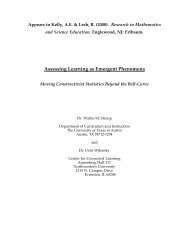Finding Forms of Flocking - The Center for Connected Learning and ...
Finding Forms of Flocking - The Center for Connected Learning and ...
Finding Forms of Flocking - The Center for Connected Learning and ...
Create successful ePaper yourself
Turn your PDF publications into a flip-book with our unique Google optimized e-Paper software.
3 Methods<br />
3.1 <strong>Flocking</strong> Models Overview<br />
For our case study we explore the parameter-space <strong>of</strong> two agent-based models,<br />
searching <strong>for</strong> a variety <strong>of</strong> target behaviors. <strong>The</strong> two ABMs are the <strong>Flocking</strong> model<br />
[20] (denoted as <strong>Flocking</strong>) <strong>and</strong> the <strong>Flocking</strong> Vee Formations model [23] (denoted<br />
as <strong>Flocking</strong> VF ). While the parameters <strong>of</strong> these two models are discussed briefly<br />
below, an in-depth discussion <strong>of</strong> these models is beyond the scope <strong>of</strong> this paper.<br />
Thus, we invite interested readers to examine the models themselves, which are<br />
both available in the NetLogo models library.<br />
<strong>Flocking</strong> closely resembles the seminal ABM <strong>of</strong> swarming behavior in artificial<br />
birds (playfully dubbed “boids”) that was introduced by Reynolds as<br />
a way to create life-like cinematic animation <strong>of</strong> flocking birds or other flying/swimming/swarming<br />
creatures [13]. <strong>The</strong> behavior <strong>of</strong> each “boid” is influenced<br />
by three basic rules, which provide impetus toward alignment, coherence,<br />
<strong>and</strong> separation. <strong>The</strong> relative influences <strong>of</strong> each are controlled by the parameters<br />
max-align-turn, max-cohere-turn, <strong>and</strong> max-separate-turn, respectively. Additionally<br />
there are parameters controlling the distance at which birds have knowledge<br />
<strong>of</strong> other birds (vision), <strong>and</strong> the minimum distance <strong>of</strong> separation which birds attempt<br />
to maintain (minimum-separation). For this first model, exploratory search<br />
tasks include the discovery <strong>of</strong> parameters that yield quick directional convergence<br />
(Section 4.1), non-convergence (Section 4.2), <strong>and</strong> volatility <strong>of</strong> the aggregate<br />
flock’s heading over time (Section 4.3).<br />
<strong>Flocking</strong> VF is based loosely on an extension <strong>of</strong> Reynolds’ work that was<br />
proposed by Nathan <strong>and</strong> Barbosa [12], attempting to produce the vee-shaped<br />
patterns <strong>of</strong>ten observed in large migratory birds, such as Canada geese. <strong>Flocking</strong><br />
VF has 8 controlling parameters, which account <strong>for</strong> fine-grained control over<br />
bird vision (vision-distance, vision-cone, obstruction-cone), takes into account benefits<br />
<strong>of</strong> “updraft” from nearby birds (updraft-distance, too-close), as well as flying<br />
speeds <strong>and</strong> acceleration (base-speed, speed-change-factor, <strong>and</strong> max-turn). <strong>The</strong> final<br />
exploratory search task is to seek parameters that best yield V-shaped flock<br />
<strong>for</strong>mations, in both <strong>Flocking</strong> <strong>and</strong> <strong>Flocking</strong> VF (Section 4.4).<br />
3.2 Search Algorithms<br />
For each search task, we tested three different search algorithms: uni<strong>for</strong>m r<strong>and</strong>om<br />
search (RS), a r<strong>and</strong>om-mutation hill climber (HC), <strong>and</strong> a genetic algorithm<br />
(GA). For all <strong>of</strong> the search methods, each ABM parameter’s value was encoded<br />
as a sequence <strong>of</strong> binary digits (bit string) using a Gray code 1 , <strong>and</strong> all the parameters’<br />
bit strings were concatenated to create a string that represents one point<br />
in the parameter-space. A bit string is evaluated by decoding it into the ABM<br />
parameter settings, <strong>and</strong> running the model with those parameters.<br />
1 A high-order binary encoding requires flipping 4 bits to change from 7 (01112) to<br />
8 (10002). In a Gray code, consecutive numbers only require a single bit flip, thus<br />
creating a smoother mapping from numbers into binary search spaces.





